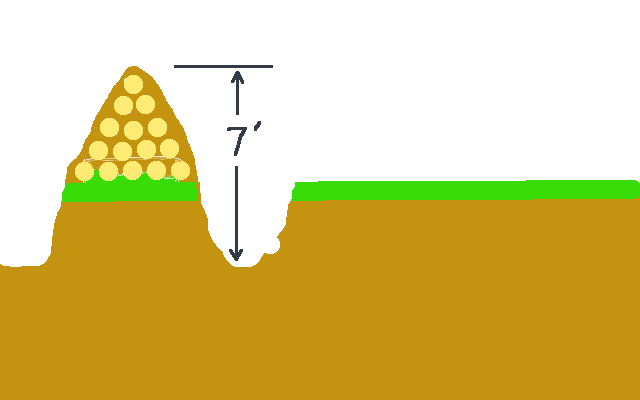


Mike Haasl wrote:This is a badge bit (BB) that is part of the PEP curriculum. Completing this BB is part of getting the sand badge in Gardening.
Jump into the full power of permaculture gardening. Create a garden that will pump out food for decades with no further effort.
Hugelkultur is laid out very well in this Richsoil Article.
To complete this BB, the minimum requirements are:
- 7 feet tall, 7 feet wide, 6 feet long
- mulch it with at least 4 different kinds of mulch
- seed/plant at least a dozen different species
- seeds are mostly nitrogen fixers (>75% by volume)
- at least three comfrey plants
- at least three sunchokes
- at least a dozen sepp holzer grains (currently available as a prize for anyone who reaches BB20)
To document your completion of the BB, provide the following:
- Two pics of the site before the work is started with the intended location marked out.
- Probably marked with wood laid on the ground that will soon be buried!
- Three pics of three different stages of construction - showing the contents of the hugelkultur
- One pic when the hugelkultur is completely built but not planted or mulched proving it is 7 feet tall and 6 feet long
- Pics of all the stuff about to be planted
- A paragraph or two of what wood was used and where it came from, what was planted, what mulches were applied and anything else interesting
- Two pics of the site after the work is complete from the same two locations as the beginning pictures.
Clarifications:
- You may use an excavator or other heavy equipment if desired. (opportunity for a two-fer with the earthworks badge)
- If you dig 3 foot deep trenches on either side of the hugelkultur spot, you can use that soil, mixed with wood, to make a hugelkultur bed that is 4 feet above grade but 7 feet tall relative to the bottom of the trench. That is one way to satisfy this BB.
- if you are building on a slope, measure the height from both sides and the average needs to be 7' or higher


paul wheaton wrote:Got the following in my e-mail and he said I could post it here:
Paul,
Hugelkultur works great. I've been doing it for about 15 years.
On your page you say:
"Hugelkultur is nothing more than making raised beds filled with rotten
wood."
I might say 'rotting' rather than 'rotten' since even fresh green wood
can be used. Also it is not absolutely essential that the material be
covered with dirt. I have created wood "terraces" with any carbonaceous
material I could get my hands on...logs, brush, etc.....and raked the
annual deposition of leaves over the material. Here in NC, where we have
high precip and humidity, the material breaks down much quicker than it
would in, say, California. I grew fabulous pumpkins, for example, in Ca
in the 8 month dry period (no rain at all) without irrigating. I used
everything organic I could accumulate, from logs to leaves, and laid it
out about 2 feet deep and planted into soil pockets.
Its amazing how the rotting wood becomes like a sponge. I can pull out
pieces that I buried two years ago and squeeze them to yield copious
amounts of water. Now when I look at wood, green or even dry, I think
"Water".
I tell my students that every unit of carbon incorporated into soils can
hold 4 units of water.
Penny Livingston, of Pc Inst of N Ca, had a few brush piles littering
her site but she didn't feel like moving or burning them, so she piled
on straw and a light scattering of soil, planted potatoes into it, and
harvested a couple bushels of spuds in addition to dissolving the "problem".
Here at Earthaven we have prohibited the burning of brush so the slower
biological 'burn' is our preferred way of managing it.
You will be greatly rewarded by using this approach. Thanks for the pix.
Keith